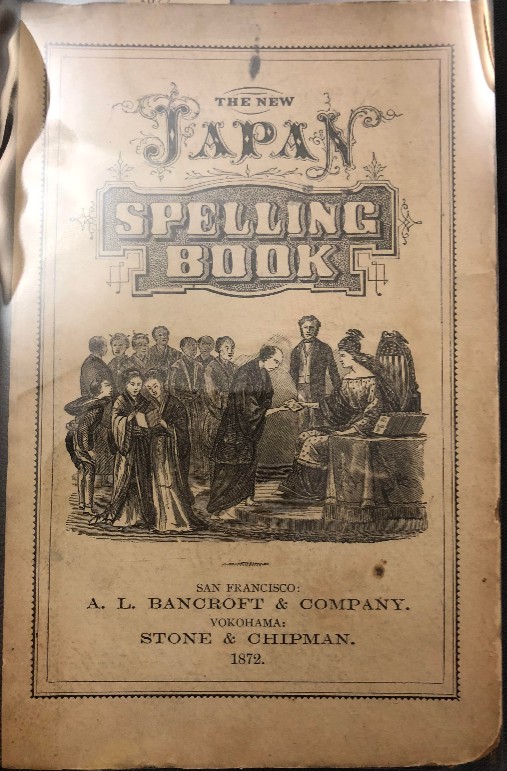
Title page of the New Japan Spelling Bookby William E. Griffis.
The New Japan Spelling Book, William E. Griffis, 1872
Written by professor of chemistry and physics, William E. Griffis, The New Japan Spelling Book is a progressive series of lessons in spelling, with exercises in reading, writing, dictation and translation. It is designed as a condensed manual of the elements of the English language for the benefit of Japanese pupils who were learning English (Griffis). The book was published by: A.L. Bancroft and Company in San Francisco as well as Stone and Chipman in Yokohama in 1872.
The publishers appear to have printed this book in a series of other books designed to integrate Japan and Western cultures. One of the introductory pages lists titles such as: New Japan Primer No. One, New Japan Pictorial Primer, New Japan First Reader, New Japan Second Reader, New Japan Third Reader, and New Japan Universal History. This particular book appears to be the 6th installation in this “New Books for Japan” series. In the preface of the book Griffis speaks directly to the teachers who may be using this book to educate the Japanese on the English language, so it is assumed that this book would be used in a classroom setting rather than for individual study.
During the early 1800’s Japan was an isolated and conservative country that suffered from a weakening economy. Throughout the century, increasing pressure from Western powers convinced Japan’s political leaders that its seclusion policy was limiting the islands advancement in technology and global trade (Met Museum). In 1867 several powerful warlords gathered and overthrew the existing Shogun and inserted Emperor Mutsuhito thus starting the Meiji Restoration era (1868-1912) (Encyclopedia Britannica).
With Emperor Mutsuhito at the helm, Japan opens its borders, sending many high level officials abroad while inviting many foreign educators, architectures and scientists to assist the island in its modernization in Western technology and knowledge (Met Museum). The New Japanese Spelling Book, was published in a time in which communication between Japanese and English speakers was crucial for the islands integration into the global economy. The authors note at the beginning of the book is dated as so: “Tokeio, May 23, 1872. Japanese 4th month, 17th day, 5th year of Meiji (Griffis). Griffis must have been one of the academics allowed into Japan soon after the opening of its borders if he wrote the note from “Tokeio”.
This particular copy of the book is about 7” in length, 5” in width and 1.5” in height. The original owners of this book took extraordinary care of the book as it is in tip top condition for being over 100 years old. The headband is still strong and the textblock is attached firmly to the cover. The cover is made of cardboard with a beautifully etched illustration of a group of Japanese diplomats exchanging text with a very regal looking westerner. Towards the end of the book there are a few stories like “Aesop's Fables” that also contain etched illustrations. There is no marbling or gold tooling, while very well put together the book seems to made for its practicality and use rather than its impressiveness. The book spans 204 pages. This book is currently held in the UCLA Special Collections Library.
References
William E. Griffis: Griffis, William. The New Japan Spelling Book. San Francisco and Yokohama. A. L. Bancroft & Company and Stone & Chipman.
The Met Museum: “Japan, 1800–1900 A.D.” In Heilbrunn Timeline of Art History. New York: The Metropolitan Museum of Art, 2000–.
The Encyclopedia Brirannica (Meji Restoration): The Editors of Encyclopedia Britannica. "Meji Restoration: Japanese History. Encyclopedia Britannica. December 14, 2015.
This spotlight exhibit by Alexander Valencia as part of Dr. Johanna Drucker's "History of the Book and Literacy Technologies" seminar in Winter 2018 in the Information Studies Department at UCLA.
For documentation on this project, personnel, technical information, see Documentation. For contact email: drucker AT gseis.ucla.edu.